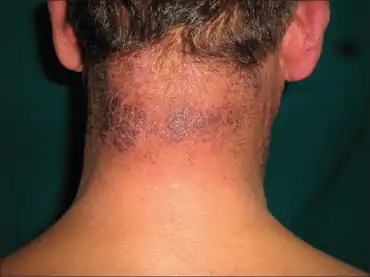Chronic actinic dermatitis
| Chronic actinic dermatitis | |
|---|---|
| Other names: chronic photosensitivity dermatitis;[1] actinic reticuloid; persistent light reactivity; photosensitive eczema[2]: 37 | |
 | |
| Chronic actinic dermatitis | |
| Specialty | Dermatology |
| Symptoms | Itchy, flaky, redness of skin typically of face, neck and backs of hands[3] |
| Usual onset | Summer[3] |
| Prevention | Longterm sun avoidance[3] |
| Treatment | Topical corticosteroid[3] |
Chronic actinic dermatitis presents with itchy, flaky, redness of sun-exposed parts of face, neck and backs of hands.[3]
It occurs as a reaction to sunlight or artificial light.[3] There may be other associated contact allergies, particularly perfumes, colophony (elastoplast and pine trees), sunscreens and composite plants (daisies).[3] Diagnosis is by its appearance and pattern of behviour.[3] Photo and patch tests may identify other co-existing allergies.[3]
Symptoms and signs
It presents with itchy, flaky, redness of sun-exposed parts of face, neck and backs of hands.[3]
Diagnosis
Diagnosis is by its appearance and pattern of behviour.[3] Photo and patch tests may identify other co-existing allergies.[3]
Reactions, which vary depending on the severity of the case, include rashes, flared 'bumpy' patches, affected areas being extremely hot to touch, and outbreaks shortly (or within 24 hours) after direct or indirect exposure to UVA and/or UVB light. The skin most likely reacts on the upper chest, hands and face, however it is not unlikely for reactions to happen all over the body. The patient may feel burning, stinging or throbbing sensations in these areas, which causes mild, yet uncomfortable pain in some patients. Others liken the pain and sensation to a chemical burn that doesn't go away. It is a mistake to think that the reaction is like a sunburn, it is far deeper in the skin and often requires the use of ingestible steroids as well as topical steroids in order to alleviate the condition to a degree. The best protection is to be fully covered from sunlight, even when cloudy or hazy. The use of UV-rated clothing is suggested as well as a UV-rated umbrella for outdoors.
Treatment
The management of Chronic actinic dermatitis is done via the following:[4]
- Emollients
- Topical corticosteroids
- Topical tacrolimus
- Systemic corticosteroids
- Azathioprine
- Ciclosporin
See also
References
- ↑ RESERVED, INSERM US14-- ALL RIGHTS. "Orphanet: Chronic actinic dermatitis". www.orpha.net. Archived from the original on 30 July 2017. Retrieved 19 April 2019.
- ↑ James, William D.; Berger, Timothy G.; et al. (2006). Andrews' Diseases of the Skin: clinical Dermatology. Saunders Elsevier. ISBN 978-0-7216-2921-6.
- 1 2 3 4 5 6 7 8 9 10 11 12 Ferguson, John S. (2019). "6. Skin and photosensitivity". In Morris-Jones, Rachael (ed.). ABC of Dermatology (7th ed.). Hoboken: Wiley Blackwell. pp. 47–48. ISBN 978-1-119-48899-6. Archived from the original on 2022-05-16. Retrieved 2022-10-02.
- ↑ "Chronic actinic dermatitis | DermNet NZ". dermnetnz.org. Archived from the original on 13 August 2021. Retrieved 19 March 2022.
External links
| Classification | |
|---|---|
| External resources |
|